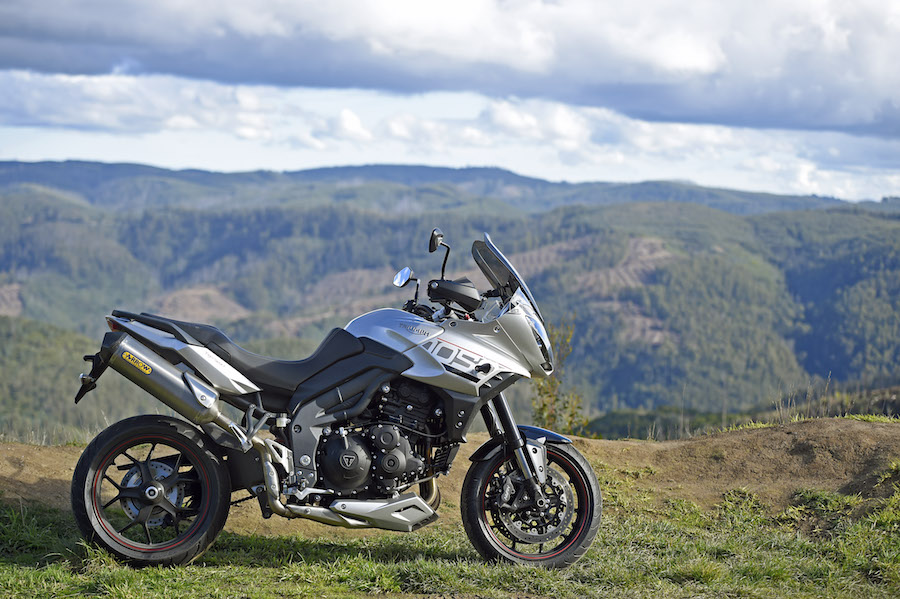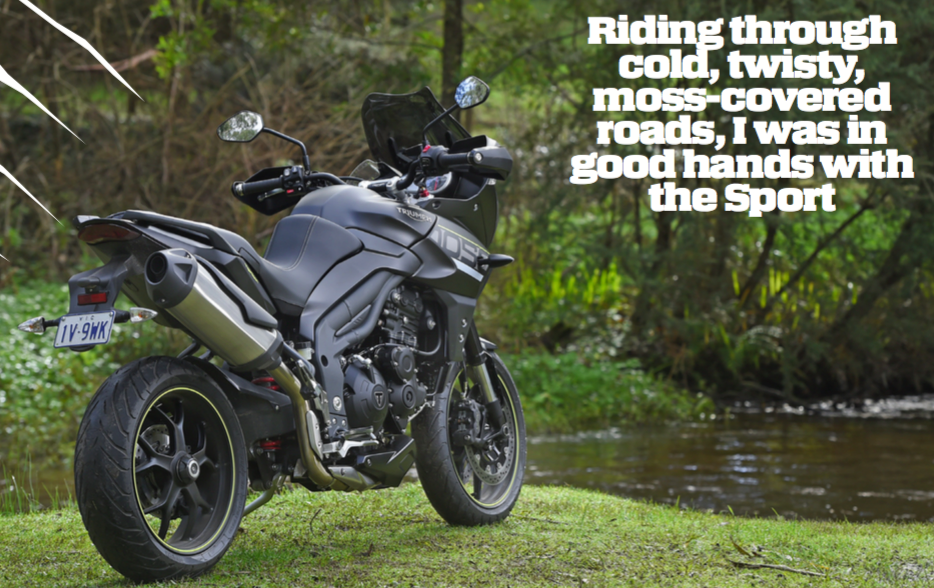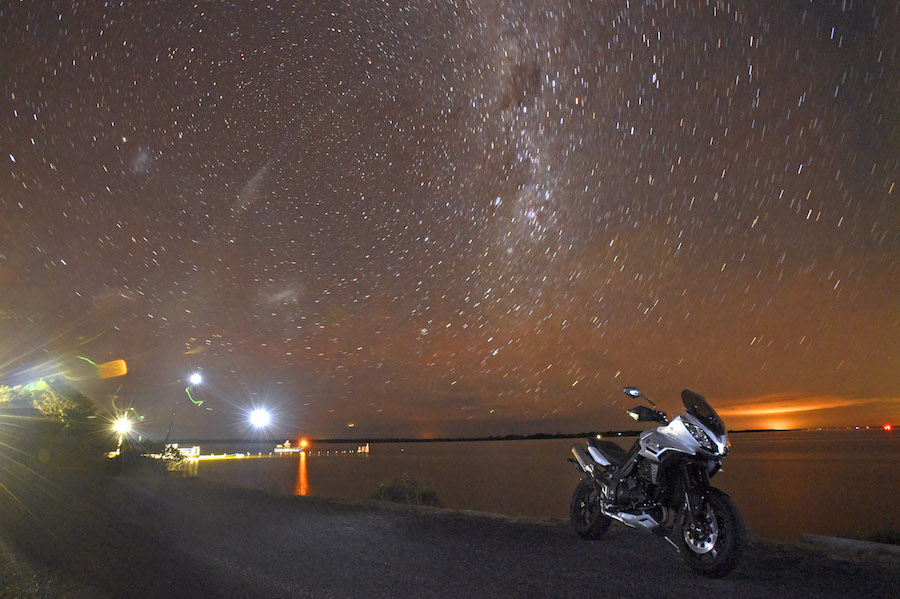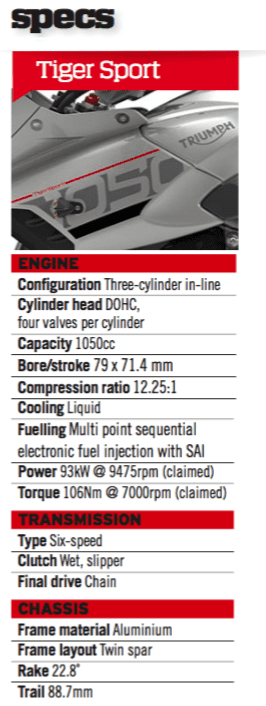The concept behind Triumph’s Tiger Sport is not new, but it’s one that’s proved hard to perfect. In the modern world most things, including motorcycles, are built for one purpose: a sportsbike has a powerful engine and needs to carve through corners like a knife; a motocrosser is light, agile and designed to win in the rough; a tourer has a big fat seat and plush suspension … you get the idea. It’s not like that when building a big adventure bike.
The concept behind Triumph’s Tiger Sport is not new, but it’s one that’s proved hard to perfect. In the modern world most things, including motorcycles, are built for one purpose: a sportsbike has a powerful engine and needs to carve through corners like a knife; a motocrosser is light, agile and designed to win in the rough; a tourer has a big fat seat and plush suspension … you get the idea. It’s not like that when building a big adventure bike.

Wheel sizes, engine capacity, configuration, weight and ergonomics are all pieced together in what the manufacturer hopes is a winning mix. But if you combine the wrong pieces and parameters it’s easy to make a flop, or ‘just another bike’ in a competitive market. BMW, Ducati, Yamaha, Suzuki, Aprilia, Honda and others all have variations of what they believe people want in the big-bore adventure bike sector, and along with Triumph they’re continually tweaking their offerings.
Of course this is far from Triumph’s first foray into the adventure market. With thousands of Tigers sold around the world and with more than 23 years’ experience building the Tiger (nine building the Tiger Sport) the UK-based company has a good idea what appeals to its customers. Triumph’s goal this time was to make the Sport the best bike it could at a sharp price point.
Objective achieved. The UK boffins have kept the retail price amazingly low, and they’ve done so without sacrificing the build quality. In fact, Triumph have enhanced this model compared to the older bike, giving it a premium feel. And there are some nice additions that you notice instantly – cruise control, adjustable screen and hand guards are now standard, while new winglets decrease wind buffeting significantly compared to last year’s model. But it’s what’s underneath that really takes this Sport to the next level.

For the first time the bike is fitted with a ride-by-wire system made by Keihin, and the development team must have spent some time on getting it right because it fuels and meters the bike’s performance faultlessly. I’m a harsh judge when it comes to throttle response as the first connection smoothness is everything. The Sport gets a big tick in that area. Thanks to the ride-by-wire system, the ride assist functions are also smoother and better than last year.
As on last year’s model, the dash is adorned with lots of the usual relevant information. It’s easy to read, although I found the map icons a little small for old eyes when on the move. That said, it didn’t take me long to work out, and I adapted. The only thing I missed was an ambient air temperature gauge, which isn’t really necessary, but probably not that hard to fit as standard equipment. Another slight inconvenience was that the maps are adjusted not on the handlebar but with the M button on the dash. While it can be done on the fly, it’s a bit tricky till you get used to it.

There are three maps: Road, Sport and Rain. The Rain map cuts the rear wheel horsepower down to just 73.5kW and provides a longer ride-by-wire adjusted throttle. We started off in Rain mode for our first wet stint from Ringwood up through Gembrook and out towards Gippsland. I instantly had a great feeling for the amount of grip the Pirelli Angel ST tyres provided, which helped me relax in the difficult conditions. Riding through twisty cold moss-covered roads isn’t my favourite pastime, but I was in good hands with the Sport. We had a wide range of riding abilities on the trip and everyone made it through the treacherous conditions, another testament to how forgiving the Sport is in these situations.
As the road dried I pulled over and changed the map to the normal Road setting, which gave me the whole 93kW to play with, and a still very smooth but more responsive throttle action. There was a big difference between the Rain and Normal map, with the latter definitely giving you more of a kick in the pants when you exit a corner. Being ride-by-wire has also made the throttle a lot lighter than the previous model, which means less energy is needed for the same distance travelled. Talking of energy savings, Triumph have also employed a new clutch mechanism which helps let the friction plates grip more with 48 per cent lighter springs resulting in a very light lever. Just these two improvements alone fight off fatigue and allow longer days in the saddle for the same effort.

I did switch on to the Sport map later in the day which in reality only changes the throttle ratio (not the power output) and left it there for the duration of the trip. I didn’t notice a massive difference between the Road and Sport map but we were mostly on country roads. Around town I’m guessing the Road map would be just the ticket. When you are pushing close to the limit, the traction control system errs on the side of caution, cutting in a little earlier than the more expensive semi-active systems available on the market. With spirited riding I liked the feeling and back-up the traction control gave me; I knew it was there and ready to cut in before I ran out of grip.
The ABS worked well too, but intervened a little too early on the front compared to top of the range sports-orientated systems. At this point though I had to remind myself that the Sport is not a racer but an all-rounder. For normal everyday use rather than riding it like a sportsbike it’s a very good quality system, and in those moments of surprise braking I trust this system will give you a good fighting chance.
Electronics is a major part of any motorcycle nowadays but the Sport’s backbone is the tried and true alloy twin-spar frame which has remained unchanged since the bike’s inception. Both the frame and single-sided swingarm can trace their roots back to 2007, and although it’s an older design it’s a still a perfect fit. To this day the frame fulfils its design parameters – commute, scratch and tour – and I’m glad Triumph didn’t change it just for the sake of changing. For a bike that weighs 218kg (dry, claimed), it’s very light to flick around, even with the panniers fitted and filled with gear, as was the case on my test bike. There was one section of back road out near Sale where we were pushing on a little and I hit one of the biggest potholes of my life on quite a lean angle. The bike took it in its stride, absorbing the impact without hesitation. I hit it so hard I thought I’d squared my rims off, but they turned out to be pretty tough too, and stayed true.

The suspension is Showa and although the same units as last year they have been modified internally with stiffer springs and different valving. Showa is high quality componentry but if I owned the bike I would definitely modify the set-up at the front and get the fork looked at by a suspension tuner. I felt the compression was slightly too stiff, and when I backed off on the adjustment screw the bump absorption was improved but I started to feel the fork drop through the stroke a bit too much under brakes. The same with the rear shock – it’s very good, does everything asked of it and is equal to the competition in its price bracket, but for the cost of a tuner I reckon you could make the Sport handle like a bike that cost 10 grand more. Don’t get me wrong – I’m being picky and we test these bikes to their limits, and there have to be some sacrifices at such an affordable retail. It’s also an easy fix that’s a cost-effective way to individualise the Sport to an owner’s needs, so therefore no big problem.
The overall finish has stepped up a notch for 2017 and it’s an area that Triumph have been working hard on. Nothing looks out of place and everything has a purpose. The engine cases have a new textured finish and along with all the other little aesthetic and quality improvements really make this bike an eye grabber. The gearbox has also been uprated this year and it’s a massive improvement on older models. Smooth accurate shifts are the norm, even after 800km in the saddle with a worn out lazy gear change foot. I would love to see a quickshift system fitted like they do on the more expensive adventure bikes, but once again you can’t have everything at $17K. The lighter clutch engages smoothly and there are no surprises or plates grabbing, as you’d expect these days.
Thanks to its increased engine performance and smooth power delivery, the Sport has taken a step up to the next level. The Tiger already has a cult following, and with the modifications made to this new model I expect ownership numbers will only grow. The DNA may be Tiger, but this Sport has the heart of a lion.

Hungry Tiger
Triumph isn’t alone in trying to steal away a big piece of the all-rounder market. It’s one that BMW had all to themselves for many years and in fact it has taken the other manufacturers a long time to realise the significant sales that can be had in this sector. Each manufacturer now seems to have sometimes several variations of the big-engine sit-up-and-beg machines swaying between off-road and on-road variants. Ducati, BMW, MV and other manufacturers have manufactured $20,000-30,000 adventure bikes with all the bells and whistles. You would think at the outset it would make sense for the Sport to take on the kings of the class directly, but that is not the competition.
Triumph has kept the Sport at a keen price of $17,150 – a bargain for the amount of motorcycle you get. That allows it to go head to head with bikes such as Suzuki’s V-Strom DL1000, Kawasaki’s Versys, and Honda’s VFR1200X Crosstourer. The Tiger Sport, however, can compete with any bike in its category, which is pretty impressive.

Local launch
There are a few different ways manufacturers can showcase new machines to the public. The launch is lavish and normally a favourite of the journo, especially the prestigious overseas international launch with caviar and champagne laid on, first class hotels and usually riding on some of the most scenic tarmac in the world.
While these events are a lot of fun, in reality we aren’t really testing the bikes under Australian conditions and mostly they’re not even ADR-spec machines. So the fact that Nigel Harvey from Triumph Marketing Australia decided to hold a Soft Launch in the middle of winter departing from Melbourne’s Peter Stevens in Ringwood was a brave move. It was proof enough though that he and Triumph Australia were confident of the new bike’s abilities under all conditions.
The mission was to grab a bunch of Triumph Tiger Sports, marry them up with the cream of the Australian bike press, then hit the road chasing as many twisty roads as possible between Ringwood and Metung. The feel of the ride was to be a bunch of guys having fun on the weekend. (I don’t think I could stuff that up.) We were to stop overnight in Metung where a few beers and maybe a monster steak would be consumed and a lot of tall stories told, before making our way back through South Gippsland the next morning. Now that’s a proper test.

104 Reasons to change
The original Tiger Sport had its Australian Launch in Tasmania way back in 2007. It’s always been a popular model for Triumph but getting a bit long in the tooth. With the new Euro4 emission limitations coming into effect by 2017, it was the right time for a major facelift. On the launch we were lucky enough to have one of the older model Sports to compare with the new model. It’s not until you get the opportunity to ride them back to back that you become aware at just how important 104 components can be. I won’t go through every item because a lot of the changes are small or insignificant, but some of the bigger improvements are worth highlighting.

- New Keihin ECU ride-by-wire system works brilliantly straight out the box by smoothing the power delivery and allowing much more scope in helping traction control work and differentiating between the different power mode maps. Road, Sport and a 73.5kW-capped Rain map all work very well. Injectors have more holes than before to increase fuel oxygenation and thus increase efficiency.
- A new cylinder head has been added to not only meet Euro4 standards but to improve rideability and efficiency. A new piston design was also needed to match the performance and efficiency gains. Power and torque are both up a little over the old engine but it’s the way in which this next generation donk delivers the power which lets this bike punch above its weight.
- Fuel consumption improved a whopping 8 per cent despite more power and more restrictive Euro4 measures.
- Lighter clutch, and lighter throttle reduce fatigue.
- The screen provides a good deal of protection and the height can be adjusted without tools.
- With speed limits so strictly enforced these days, cruise control is an absolute godsend on the freeway.
- Upgraded finish. With new finishes and ever-evolving processes this Triumph is tip top in its presentation
- The gearbox has received an overhaul making shifts clean and slick compared to the old model.
- A new stronger alternator keeps more stable current running at idle. It’s not new, but a USB charging port under the seat and added to the accessory socket on the left hand side make powering up easy.

TEST STEVE MARTIN PHOTOGRAPHY JEFF CROW













